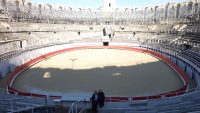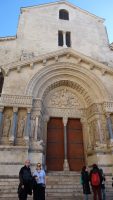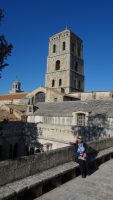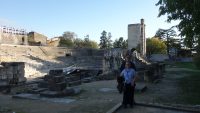 Late November is definitely off-season for tourism in the south of France. Add to that the fact that many businesses close on Mondays, and there can be some challenges because of this. But the off-season also brings some spectacular opportunities that you would never see in July.
Late November is definitely off-season for tourism in the south of France. Add to that the fact that many businesses close on Mondays, and there can be some challenges because of this. But the off-season also brings some spectacular opportunities that you would never see in July.
We are staying in the town of Avignon, but we took a short train ride to Arles. Mer and I had been there before, back during our tour-the-whole-country trip with Mer’s parents in 2007. On that trip, we had been moving every day, which limited touring opportunities. Then, we only remember seeing the city’s excellent Roman coliseum, and that was pretty much it.
 Today, we had the entire day. We walked in from the train station, pausing to look at the Rhone River, which is a working river with lots of large boats. We strolled into the winding streets of the old city center, and Mer remembered the hotel where we stayed back in 2007, and she was right (of course). The first real stop of the day was the coliseum.
Today, we had the entire day. We walked in from the train station, pausing to look at the Rhone River, which is a working river with lots of large boats. We strolled into the winding streets of the old city center, and Mer remembered the hotel where we stayed back in 2007, and she was right (of course). The first real stop of the day was the coliseum.
Arles was an important Roman city, both for trade purposes and for supporting the winning side in Julius Caesar’s power struggle. For both, they were rewarded with Roman buildings, like a circus for racing chariots, a forum, a 20,000-seat coliseum, and a 10,000-seat theater. The coliseum is amazingly well preserved, and is still in use today for sporting events.
 We bought a “Liberty Card” at the gate, which lets you get into four different sites and two museums, all for a price lower than seeing two things. Here is where the off-season fun began. We walked into the arena, and, other than one worker working in the nosebleed seats, we had the entire arena to ourselves. And two cats. Other people did come in later, but for a good ten minutes, we were all alone in the entire site. And, even after we ran into other people, it was a total of three tourists, in a place that can still seat thousands. It was pretty great. We sat up as high as the pubic is allowed for tourism, which is about halfway up the existing seats. That was followed by walking three quarters of the way around the place, and that led us to the medieval tower that can be climbed. During the Middle Ages, the coliseum was converted into a small walled town, with two hundred houses and four defensive towers. One of the towers is open to the public, and offers great views of the countryside. Since Dubbs (our friend Ami) teaches Latin, she was geeking out. A little.
We bought a “Liberty Card” at the gate, which lets you get into four different sites and two museums, all for a price lower than seeing two things. Here is where the off-season fun began. We walked into the arena, and, other than one worker working in the nosebleed seats, we had the entire arena to ourselves. And two cats. Other people did come in later, but for a good ten minutes, we were all alone in the entire site. And, even after we ran into other people, it was a total of three tourists, in a place that can still seat thousands. It was pretty great. We sat up as high as the pubic is allowed for tourism, which is about halfway up the existing seats. That was followed by walking three quarters of the way around the place, and that led us to the medieval tower that can be climbed. During the Middle Ages, the coliseum was converted into a small walled town, with two hundred houses and four defensive towers. One of the towers is open to the public, and offers great views of the countryside. Since Dubbs (our friend Ami) teaches Latin, she was geeking out. A little.
 On to the next site! We walked a short way down to St. Trophime Church, which is a twelfth-century building with an intact Romanesque facade that is crammed full of carvings of people on Judgement Day, and is open to a cute square with an obelisk in it. The interior of the church is worth seeing too, with multiple side chapels and several good works of art. We met a very friendly man who explained to Meredith the symbolism of a sailor’s cross (in French), and then Mer translated the gist. He was kind for taking the time to help us; I think he worked for the church in some maintenance capacity, but he was happy to talk with us.
On to the next site! We walked a short way down to St. Trophime Church, which is a twelfth-century building with an intact Romanesque facade that is crammed full of carvings of people on Judgement Day, and is open to a cute square with an obelisk in it. The interior of the church is worth seeing too, with multiple side chapels and several good works of art. We met a very friendly man who explained to Meredith the symbolism of a sailor’s cross (in French), and then Mer translated the gist. He was kind for taking the time to help us; I think he worked for the church in some maintenance capacity, but he was happy to talk with us.
From the church, we walked around the corner to the associated cloisters, which were included on our Liberty Card. The cloisters had an enclosed green space (formerly used as a graveyard), and was a quiet and pretty place to be. The covered walkways were heavily carved with statues depicting Bible stories and some local legends. In a surprise to us, the cloisters had three exhibits on creche (nativity) scenes – one room by talented amateurs, one room by professional artists, and one by artists from Mozambique. I liked creches from all three rooms – some were carved, some were done with needlework, one used gourds, and one was even made of tasteful finger puppets. We took the time to look at all of them.
 After a quick lunch, we walked though a maze-like series of streets to soak up the atmosphere of the local town, on our way out to the Ancient History Museum on the edge of town. The lanes we saw were wonderful and cute and very effective in turning us around. We came out of them with no real idea where the river was and where the museum would be. Dubbs rescued us with her phone, which promptly sent us through a slightly dodgy neighborhood which seemed to have too many adults sitting around on a Monday afternoon. We did find the museum, however, and that was good.
After a quick lunch, we walked though a maze-like series of streets to soak up the atmosphere of the local town, on our way out to the Ancient History Museum on the edge of town. The lanes we saw were wonderful and cute and very effective in turning us around. We came out of them with no real idea where the river was and where the museum would be. Dubbs rescued us with her phone, which promptly sent us through a slightly dodgy neighborhood which seemed to have too many adults sitting around on a Monday afternoon. We did find the museum, however, and that was good.
The museum started with Arles pre-Roman, but someone (who teaches Latin) wanted to move efficiently along to the Romans. The museum excels there – probably eighty percent of the museum or more is Roman-related. They have excellent models of the whole town in different centuries, and ones of the coliseum, the circus, the forum, and the theater, all laid out in their (best-guess) original splendor. They have tons of pots, a bunch of sculptures, several mosaic floors with a suspended walkway to see them, and many sarcophagi from the early Christian period, but the showstopper is a 2,000-year-old river boat.
Archaeologists found the boat in the river in the early 2,000s, and the boat was largely intact. So began a several-year process of figuring out how to raise the boat (after cutting it into ten sections) and how to preserve the boat for initial prepping and for the long term; that involved soaking in resin and then exposing it to gamma radiation to cure any metal parts like nails. The boat was painstakingly put back together, and is now well housed in the museum, surrounded by objects recovered around the boat from the river excavations. It was pretty great getting to see the scale of the vessel, and they even had it partially loaded with the original cargo of rocks.

It was easier to find the river path for the fifteen-minute walk back into the city center. We were still in time to see the ruins of the Roman theater; admission was still on our Liberty Card. Yay, us! The theater is not in so good a condition as the coliseum, but is still excellent, and the theater is still used as such – it still has seating for 6,000, although most of those seats came from an 1800s renovation. The original Roman seats only go up eight or nine rows, but the original space in front of the stage still exists, as does one set of columns for the stage wall. There are lots of ruins around as well to give visitors some idea of the size of the backstage buildings.
 The last free-to-us site was the underground Cryptoporticos, which were the support structures for the forum buildings. This one was a tad disappointing in that it is just a really really long and empty cellar. And old cellar, but just a cellar.
The last free-to-us site was the underground Cryptoporticos, which were the support structures for the forum buildings. This one was a tad disappointing in that it is just a really really long and empty cellar. And old cellar, but just a cellar.
After checking out the Forum Square, which has the “Night Cafe” made famous by Van Gogh, and then looking around a small church next to a scenic overlook, we finished our evening in Arles with a good meal at an open restaurant that we stumbled upon on our way back to the train station. The downside of off-season travel on Mondays showed up when the first two restaurants we tried to find today were both closed, as was the case with the crepe place AND ice cream place we wanted to go to back in Avignon. Nonetheless, it’s still worth it, even if food can be a little harder to find.
“As high up as allowed for tourists”. Huh. When we were there, insane people in my party stood on the tops of the walls with imminent death just waiting in the street below.
Will mention that even in July, there were only a couple dozen tourists in the arena.
BTW, if this is the off season in Paris, can’t imagine what summer is like.
It must have changed recently then – there is no physical way I saw to get to the top of the wall in Arles. You can get to the top easily in Nimes, but in Arles, everything was either roped off pretty clearly or separated by a huge gap in the stones.
Oh, oops. Got those confused. I meant Nimes.
Yes, Nimes was tourist-beware at the top. I almost did not go there because I thought it was unsafe, but Dubbs pointed out I could stand in the arena seats and be safe. Great amphitheater, thought.